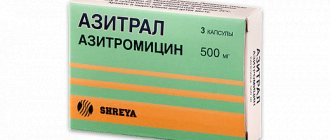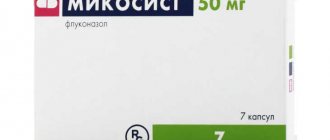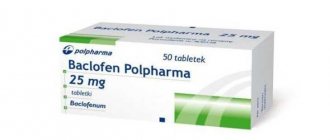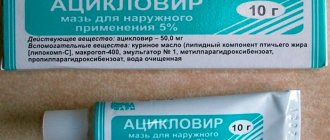Author of the article
Evgeniy Nikolaevich Konoplev
Reading time: 6 minutes
AA
The main active ingredient in the drug Cifran Od is ciprofloxacin. The medicine has a wide spectrum of action and is included in the group of fluoroquinols. The drug is used to treat infections of various natures, but does not destroy bacteria in the central nervous system. Often prescribed to treat bacterial diseases.
Medicinal form
This medication is presented in the form of oval white pills. Each of them is covered with film. There is a special marking on one side. Edible ink is usually used to apply the inscription. When scrapped, the pill may have a slight tint. Thus, the medicinal form of this medicine is tablets, which are packaged in blisters of five pieces. The box contains one or two blisters.
The oval-shaped pills are covered with a coating that is almost white in color. Their length is 17, width - 8, and thickness - 5 millimeters (for dosing 500 mg). For a dosage of 1000 milligrams, the length is 21, the width is 10, and the thickness is 7 millimeters.
Compound
The active component of this drug is the substance ciprofloxacin. "Cifran OD" 500 contains 500 milligrams of such an active ingredient. Besides this, there is another form of medicine. According to the instructions, Cifran OD 1000 contains 1000 milligrams of the active ingredient. Additional components are: alginate along with sodium bicarbonate, magnesium stearate, talc and silicon dioxide. The chemical composition of the tablet shell is prepared from opadra, hypromellose and edible ink.
Indications
The drug "Cifran OD" is used as a treatment for pathologies that are caused by pathological organisms. Thus, this remedy is prescribed for the following diseases:
- When sinusitis occurs, pathologies of the respiratory canals are infectious in nature, which may be accompanied by inflammation.
- It is advisable to use "Cifran OD" for various forms of cystitis, pyelonephritis, chronic prostatitis of a bacterial nature and gonorrhea.
- For intra-abdominal pathologies with complications. In this case, therapy is usually prescribed in combination with Metronidazole.
- According to the instructions for use, “Cifran Ode” is prescribed for a pathological process on the skin of an infectious nature.
- In case of infectious pathological processes in joints and bone tissues, against the background of stool disorders provoked by infections, typhoid fever and cholecystitis.
Indications for use of the drug Tsifran OD
Uncomplicated and complicated infections caused by pathogens sensitive to ciprofloxacin:
- respiratory tract infections: pneumonia caused by Klebsiella spp., Enterobacter spp., Proteus spp., Escherichia coli, Pseudomonas aeruginosa, Haemophilus spp., Moraxella catarrhalis, Legionella and staphylococci;
- infections of the middle ear and paranasal sinuses;
- infections of the abdominal organs, bacterial infections of the gastrointestinal tract, gall bladder and biliary tract, as well as peritonitis;
- kidney and urinary tract infections;
- infections of the pelvic organs (gonorrhea, adnexitis, prostatitis);
- skin and soft tissue infections;
- infections of bones and joints.
Pharmacodynamics
The drug destroys almost all pathological microscopic organisms. This long-acting medication is distinguished by the fact that after taking it, the active component is very easily absorbed from the digestive system. "Ciprofloxacin" can be released long enough and evenly. Thanks to all this, the pills are taken once a day.
As stated in the instructions for “Cifran OD” 500, as well as the dosage of 1000 milligrams, this medicine allows you to shorten the duration of treatment. Ciprofloxacin with a dosage of 250 milligrams will need to be used several times more or more often. The maximum concentration can be achieved in the circulatory system within a few hours. The maximum amount of the active component in the blood of "Cifran OD" is 500 milligrams - 1.3 micrograms per liter. With a large dosage, this figure may differ. For Tsifran OD 1000 mg it is 2.4 micrograms per liter.
Up to forty percent of cyclofloxacin is usually bound to proteins. The active ingredient is absorbed into the tissue very quickly and quite easily. The substance can be found in the lungs, in the fat layer, in addition, it is found in muscles, cartilage tissue, bones, bronchi, saliva, sperm and directly in the secretion of the prostate gland. The drug is usually degraded by the liver and excreted by the kidneys (about fifty percent). The remainder of the medicine is stored in the blood, entering the liver, then into the bile ducts and intestines. This movement of the drug in the body is called enterohepatic circulation, due to which the effects of ciprofloxacin can last longer.
Release form and properties
The medicine is sold in the form of ear and eye drops, eye gels, injections and infusions, and pills. Analogues of Tsifran Od, which contain similar active ingredients:
- tsipromed;
- ciprolacare;
- ciprodox;
- microflox;
- tsiprosan.
The drug destroys the membrane and cellular walls of bacteria, and thanks to it, DNA abnormalities are suppressed. As a result, the development of microorganisms stops. The action of Tsifran is almost instantaneous, so microorganisms do not have time to adapt to it and quickly die. The medicine ends up deep in the tissue - this is an indispensable property in the treatment of difficult diseases, because getting rid of localized foci of infection is always difficult.
Cifran is easily combined with other antibiotics, for example, aminoglycosides or penicillins. The medicine has a minimal amount of inhibitory concentration, that is, to cope with the infection, you will need a small amount of the active ingredient. The range of effects of the drug is wide. Tsifran fights with:
- Aerobic microorganisms.
- Gram-positive and gram-negative pathogens (salmonella, Escherichia coli and Pseudomonas aeruginosa, Shigella, meningococci, gonococci).
- Staphylococcus, mycobacteria, chlamydia, legionella, mycoplasmosis and other pathogens.
Pharmacokinetics
Cifran OD sustained-release tablets are designed to release the drug at a lower rate than rapid-release tablets. The pharmacokinetic profile of "Cifran Ode" 1000 in the instructions is compared with a 500 milligram dosage of ciprofloxacin, which is characterized by rapid release.
After oral use, ciprofloxacin is rapidly absorbed, which occurs mainly in the small intestine. The maximum concentration of this substance is achieved in the blood serum after two hours. The biological availability of the drug is about eighty percent. The value of the maximum concentration in blood plasma increases in proportion to the dose.
The binding of ciprofloxacin to blood plasma protein is thirty percent. The active component is present in blood plasma mainly in non-ionized forms. The component ciprofloxacin can be freely distributed in tissues and body fluids. Typically, the volume of distribution in the body is 3 liters per kilogram. The concentration of ciprofloxacin in the tissue is significantly higher than that in the blood serum.
Pharmacological properties of the drug Tsifran OD
Pharmacodynamics. in vitro activity against a wide range of gram-negative and gram-positive microorganisms. The bactericidal effect of ciprofloxacin is the result of inhibition of the enzymes topoisomerase II (DNA gyrase) and topoisomerase IV, which are necessary for replication, transcription, repair and recombination of bacterial DNA. The mechanism of action of fluoroquinolones, including ciprofloxacin, differs from the mechanism of action of penicillins, cephalosporins, aminoglycosides, macrolides and tetracyclines. Therefore, microorganisms resistant to these classes of drugs may be sensitive to ciprofloxacin and other quinolones. There is no known cross-resistance between ciprofloxacin and other classes of antibacterial drugs. In vitro resistance to ciprofloxacin develops slowly. Ciprofloxacin is active against most strains of the following microorganisms both in vitro and in clinical infections; aerobic gram-positive microorganisms: Enterococcus faecalis (many strains are moderately sensitive), Staphylococcus aureus (MSSA), Staphylococcus epidermidis (MSSA), Staphylococcus saprophyticus, Streptococcus pneumoniae (PSSP), Streptococcus pyogenes ; aerobic gram-negative microorganisms: Campylobacter jejuni, Citrobacter diversus, Citrobacter freundii, Enterobacter cloacae, Escherichia coli, Haemophilus influenzae, Haemophilus parainfluenzae, Klebsiella pneumoniae, Moraxella catarrhalis, Moraxella morganii, Neisseria gonorrhoeae, Proteus mirabilis, Proteus vulgaris, Providencia rett geri, Providencia stuartii, Pseudomonas aeruginosa, Salmonella typhi, Serratia marcescens, Shigella sonnei, Shigella boydii, Shigella dysenteriae, Shigella flexneri. Ciprofloxacin is also active in vitro and through the use of a surrogate marker for Bacillus anthracis. Ciprofloxacin has in vitro minimum inhibitory concentration (MIC) of ≤1 μg/ml against the majority (90%) of strains of the following microorganisms: aerobic gram-positive microorganisms: Staphylococcus haemolyticus, Staphylococcus hominis, Streptococcus pneumoniae (PRSP); aerobic gram-negative microorganisms: Acinetobacter iwoffi, Pasteurella multocida, Aeromonas hydrophila, Salmonella enteritidis, Edwardsiella tarda, Vibrio Cholerae, Enterobacter aerogenes, Vibrio parahaemolyticus, Klebsiella oxytoca, Vibrio vulnificus, Legionella pneumophila, Yersinia enterocolitica. Most strains of Burkholderia cepacia and some strains of Stenotrophomonas maltophilia are resistant to ciprofloxacin, as are most anaerobic bacteria, including Bacteroides fragilis and Clostridium difficile. Pharmacokinetics. Extended-release ciprofloxacin tablets are formulated to release the drug more slowly than traditional immediate-release tablets. Extended-release ciprofloxacin tablets and immediate-release ciprofloxacin tablets are not interchangeable. The pharmacokinetic profile of ciprofloxacin extended-release tablets 500 and 1000 mg once daily is similar to that of the immediate-release 250 and 500 mg tablets twice daily in terms of AUC over a 24-hour period. The volume of distribution for intravenously administered ciprofloxacin is approximately 2.1–2.7 L/kg body weight. The results of studies conducted with oral and intravenous use of ciprofloxacin indicate that, depending on the route of administration, the drug penetrates into different tissues. The binding of ciprofloxacin to serum proteins is 20–40%. There were 4 metabolites identified in urine. These metabolites have less pronounced antimicrobial activity than unchanged ciprofloxacin. Excretion of these metabolites occurs almost completely within 24 hours after administration of the drug. The elimination kinetics of extended-release ciprofloxacin are similar to those of immediate-release ciprofloxacin tablets. Approximately 35% of an orally administered dose is excreted unchanged in the urine. Excretion in urine occurs almost completely within 24 hours after administration of the drug. Approximately 20–35% of an orally administered immediate-release ciprofloxacin dose is excreted in the feces over a 5-day period. In patients with reduced renal function, the half-life of ciprofloxacin is prolonged to a small extent.
Reception by elderly patients
Pharmacokinetic analysis of immediate-release oral pills (single dosing) and intravenous forms of ciprofloxacin (multiple doses of the drug) confirms, as described in the instructions for Cifrana OD 1000, that plasma concentrations of the active ingredient are significantly higher in older adults ( who are over sixty-five years of age) compared to young adults. The maximum concentration increases from sixteen to thirty percent, which may be due in part to decreased renal clearance in elderly patients. The half-life is only slightly longer in older adults. This difference is not clinically significant.
Medicinal properties
Digital od acts directly on the DNA of the bacterium, regardless of whether it is at rest or multiplying and developing. The drug inhibits DNA gyrase, which prevents the joining of two DNA strands in bacteria. Protein synthesis becomes impossible.
Ciprofloxacin penetrates equally easily into liquid media and tissues: saliva, mucous membranes, sperm, lymph, prostate gland, lungs, adipose tissue, muscles, bones, and so on. This explains the wide range of uses of the drug.
Half of the drug is excreted from the body through the kidneys, another 15% is also excreted in the urine, but in the form of metabolites (metabolic products), the rest is removed by the intestines. The half-life is about 7 hours.
In case of kidney failure
In patients with reduced function of this organ, the half-life of ciprofloxacin may be significantly prolonged. No dosage adjustment is required for patients with uncomplicated urinary tract infections who receive 500 milligrams of the long-acting dosage form of this substance. For complicated urinary tract infections and pyelonephritis, where a dose of 1000 milligrams of Cifran OD is used, it should be transferred to another dosage of ciprofloxacin with prolonged action, namely up to 500 milligrams once a day (creatinine clearance will be below 30 milliliters per minute).
Cifran OD or Cifprofloxacin
Cifprofloxacin.
Photo: megakopter.ru These two drugs are analogues of each other. Release form of Tsifran OD: extended-release tablets. The drug Ciprofloxacin has a more varied release form: film-coated tablets, eye/ear drops, solution for intravenous administration. Tsifran OD is used once. Ciprofloxacin is prescribed up to 2 times a day. Both drugs are prescribed by a doctor! Ciprofloxacin is cheaper in cost than Cifran OD.
Taking medications by special categories of patients
It is worth paying attention to the use of this medication in patients suffering from serious renal impairment. The instructions for use of “Cifran OD” state that if there is a slight malfunction in the functioning of this organ, the half-life of the active component increases slightly. Taking this factor into account, the doctor must adjust the dosage and duration of treatment.
It is worth paying attention to the use of this medication in cases of liver dysfunction. The studies were conducted among patients suffering from liver cirrhosis, and no significant changes in the effects of the drug were observed.
There are also some instructions for taking Cifran OD during pregnancy. Given the high penetrating ability of this drug, using this medicine during pregnancy is highly not recommended. But it is worth noting that during lactation, the use of this drug is quite possible if the risks to the woman’s life are higher than the danger to the baby, however, breastfeeding should definitely be stopped.
Contraindications
Like all medical products, this one has various contraindications, which in no case should be ignored, since otherwise you can cause extremely undesirable consequences for your body. So, among the contraindications in the instructions are the following conditions and pathologies in the patient:
- The presence of intolerance to the drug along with its individual components.
- The patient's age is up to eighteen years and pregnancy.
- Development of pseudomembranous colitis.
- It is worth emphasizing once again that lactation is not an absolute contraindication for the use of this medication.
The use of "Cifran OD" 1000, as well as its other dosage, is carried out with great caution in the following cases:
- If the patient has atherosclerosis, characterized by progressive symptoms.
- The appearance of blood flow disorders in the brain.
- The occurrence of epilepsy.
- The patient is over sixty-five years of age.
- Presence of failure (renal or liver).
Side effects
The instructions for patients report various adverse reactions that may occur when taking this medication:
- The digestive organs are capable of reacting to its intake with nausea (in rare cases, vomiting is also possible). Abnormal bowel movements, along with discomfort and a feeling of bloating in the abdominal area, are possible. In addition, anorexia is possible along with hepatitis. If the patient has suffered liver pathologies, then symptoms of jaundice may also occur.
- The nervous system can react with fear of light, sleep disturbances, irritability, dizziness, fatigue, anxiety, confusion and depression.
- According to the instructions, “Tsifran OD” also provokes side effects in the functioning of the sense organs in the human body. We are talking about distortion of taste buds, perception of color and smell. It is also quite possible that there are extraneous sounds in the ears.
- The cardiac and vascular system is capable of reacting with tachycardia, pressure surges, flushes of blood in the facial area, and pulse surges.
- As for the hematopoietic system, in this case leukocytosis in combination with anemia, leukopenia and eosinophilia is quite possible.
- The urinary system is capable of reacting with nephritis in the acute phase (it is worth saying that in quite rare cases, patients develop kidney failure). Hematuria, along with dysuria, urinary retention in the body and albuminuria, cannot be excluded.
- Allergic reactions in the form of itching and hives are also likely, while patients often develop blisters accompanied by bleeding. The appearance of scabs and small nodules is possible. Pinpoint hemorrhages also form on the skin. In rare cases, swelling of the face and larynx may appear along with shortness of breath, vasculitis, various forms of erythema and necrolysis.
- The musculoskeletal system may respond with arthritis, myalgia, arthralgia, and tenosynovitis. It is also important to note that in some cases, patients may experience excessive sweating along with general weakness, and candidiasis may also develop.
Side effects of the drug Cifran OD
Frequency ≥1, ≤10% Gastrointestinal tract: nausea, diarrhea. Skin: skin rash. Frequency ≥0.1, ≤≤1% Body as a whole: abdominal pain, candidiasis, asthenia. Gastrointestinal organs: increased levels of liver transaminases: ALT, AST, ALP, vomiting, dyspepsia, anorexia, flatulence, bilirubinemia. Hematopoietic system: eosinophilia, leukopenia. Urinary system: increased levels of creatinine, urea nitrogen. Musculoskeletal system: arthralgia. CNS: dizziness, headache, sleep disturbance, agitation, confusion. Skin: itching, maculopapular skin rash, urticaria. Sense organs: taste disturbance. Frequency ≥0.01, ≤≤0.1% Body as a whole: pain, pain in the extremities, pain in the back, in the chest. Cardiovascular system: tachycardia, migraine, syncope, vasodilation, hypotension. Gastrointestinal organs: candidiasis (oral), jaundice, cholestatic jaundice, pseudomembranous colitis. Blood system and lymphatic system: anemia, leukopenia (granulocytopenia), leukocytosis, changes in prothrombin levels, thrombocytopenia, thrombocythemia (thrombocytosis). Hypersensitivity: allergic reaction, drug fever, anaphylactic reactions. Metabolic disorders: edema (peripheral, vascular, facial), hyperglycemia. Musculoskeletal system: myalgia, joint swelling. CNS: migraine, hallucinations, sweating, paresthesia (peripheral paralgesia), anxiety (fear, anxiety), sleep disturbance (nightmares), convulsions, hypersthesia, depression, tremor. Respiratory system: dyspnea, laryngeal edema. Skin: photosensitivity reaction. Sense organs: tinnitus, temporary deafness (especially at high frequency sounds), visual impairment (visual abnormalities), diplopia, chromatopsia, loss of taste (taste disturbance). Genitourinary system: acute renal failure, renal dysfunction, vaginal candidiasis, hematuria, crystalluria, interstitial nephritis. Frequency ≤0.01% Cardiovascular system: vasculitis. Gastrointestinal organs: candidiasis, liver necrosis (very rarely - progressing with the development of life-threatening liver failure), pseudomembranous colitis with a possible fatal outcome, pancreatitis, hepatitis. Blood system and lymphatic system: hemolytic anemia, petechiae, agranulocytosis, pancytopenia (life-threatening), bone marrow suppression (life-threatening). Hypersensitivity: shock (anaphylactic, life-threatening), skin rash, serum sickness-like reaction. Metabolic disorders: increased activity of amylase and/or blood lipase. Musculoskeletal system: myasthenia gravis, tendinitis (mainly Achilles tendonitis), partial or complete tendon rupture (mainly Achilles tendon). CNS: severe cramps of large muscles, gait instability, psychosis, intracranial hypertension, ataxia, hypersthesia, tic. Skin: petechiae, erythema multiforme, erythema nodosum, Stevens-Johnson syndrome, epidermal necrolysis (Lyell's syndrome), persistent skin rash. Sense organs: parosmia, loss of smell (usually reversible when the drug is discontinued).
Mode of application
Dosage and treatment regimen are established depending on a complex of various factors. For example, this may depend on the severity of the infection, as well as on the intensity of symptoms, the cause of the pathology, the patient's age, weight and kidney function. These tablets are taken exclusively after eating food. Therapy is continued three times after the symptoms of the pathology are eliminated. Treatment regimens are usually as follows:
- In the presence of acute sinusitis, according to the instructions, “Cifran Ode” 500 is prescribed once daily for ten days.
- If infectious pathologies of the respiratory system occur, 500 milligrams are prescribed daily for three weeks.
- In the event of an acute infectious pathology, according to the instructions, “Tsifran OD” 500 is prescribed daily for three days.
- In the event that infectious pathologies are severe and complicated by concomitant diseases, then 1 gram of the drug is prescribed daily, and the course of treatment itself lasts up to several weeks.
- If pathologies of the urinary canal occur, 500 milligrams of medication is prescribed every day, and the course duration is ten days.
- When prostatitis appears in the chronic phase, 500 milligrams of the drug is prescribed daily, and the total duration of treatment is ten days. If a severe intra-abdominal infection occurs, this drug is prescribed in combination with Metronidazole according to the following regimen: 1 gram daily for several weeks.
- When a skin infectious pathology appears, 500 milligrams of the medication is prescribed every day for two to three weeks.
- For severe skin infectious pathology, patients are prescribed 1 gram of this medication daily for two to three weeks.
- If an infectious pathological process of joints and bone tissue occurs, which occurs in an uncomplicated form, 500 milligrams of the drug are prescribed daily for two months.
- If the pathological process in bone tissues and joints is severe, then one and a half grams of the drug is prescribed daily for six weeks.
- If typhoid fever occurs, 500 milligrams of this medication are prescribed daily for ten days.
Treatment of children
The medication is very rarely prescribed to children. If absolutely necessary, the daily dose is 10 mg/kg per day. The drug infusion is administered into a vein from a 100 ml bottle. The drug contains 0.9% sodium chloride. It is prohibited to use if the solution has changed color or if foreign particles have appeared in it. This occurs due to improper storage or improper transportation. When treating children, the solution is compatible with the following drugs:
- Betamethasone.
- Pheniramine maleate.
- Dexamethasone.
- Lidocaine.
- Fortvin.
- Metoclopramide.
You can combine with Cifran other medications that are used when the patient is in a serious condition. The duration of treatment depends on the anomaly of the disease, bacteriological information, and the clinical picture of the patient. As a rule, treatment of infectious diseases takes from 6 to 8 days. Even if the symptoms and other signs of the disease have disappeared, treatment is continued for 2 days.
If necessary, intravenous administration of the drug is replaced by oral administration. Cases of drug overdose are unknown. The drug is stored in a dark place, inaccessible to children, at a temperature of no more than 26 C. Shelf life - 24 months. Dispensed from the pharmacy with a prescription.
Overdose
The instructions for use of "Cifran Ode" 1000 indicate that in the event of an overdose, characteristic symptoms may appear when the patient does not adhere to the treatment regimen that was prescribed for him. Signs of this condition are:
- The appearance of confusion and disorientation.
- The occurrence of constant fatigue, dizziness, and nausea accompanied by vomiting.
- Appearance of disorientation.
It is important to note that there is no specific drug for overdose as such; treatment is prescribed based on certain specific signs. Hemodialysis and dialysis are also prescribed.
Overdose of the drug Cifran OD, symptoms and treatment
Symptoms: reversible renal failure. Treatment: rinse the stomach, induce vomiting; the patient should be carefully monitored and receive supportive care, including monitoring of renal function; administration of antacids containing magnesium, aluminum or calcium, which may reduce the absorption of ciprofloxacin; maintaining adequate water regime. Only a small amount of ciprofloxacin (≤10%) is removed from the body by hemodialysis or peritoneal dialysis.
Interaction with other medications
When treated with this medicine in combination with corticosteroids in patients who are over sixty years of age, the likelihood of tendon injury may be significantly increased. When drugs that promote alkalinization of urine are prescribed together with Tsifran OD, the likelihood of a nephrotic effect increases. There is a high risk of neurotoxic effects during simultaneous therapy with this drug and other anti-inflammatory non-steroidal drugs.
It is also very important to maintain a two-hour break between taking antacid medications and Cifran OD. Otherwise, the effectiveness of the medication in question decreases sharply. Food may negatively affect the overall rate of absorption of the active ingredient.
Increased photosensitivity has been reported in patients treated with fluoroquinolones. During the treatment period, it is necessary to limit exposure to ultraviolet radiation and sunlight. If sensitivity to light increases sharply, the doctor decides to reduce the dosage or discontinue the drug. In such a situation, it is replaced with another medication.
The instructions for use of "Cifran" 1000 indicate that this drug has a reversible toxic effect on the kidneys. It is not recommended to prescribe these tablets in the presence of disturbances in the functioning of the kidneys, as well as against the background of hemodialysis and dialysis. This drug can provoke the development of pseudomembranous colitis.
The pathological process can manifest itself in the usual mild form or in a severe, life-threatening condition for the patient. In the event that treatment is accompanied by prolonged and severe diarrhea, and stool disturbances appeared immediately after using the medicine, then a study will be required to exclude the possibility of pseudomembranous colitis. When such a diagnosis is confirmed, the described drug must be immediately discontinued and symptomatic treatment carried out.
In order to exclude the possibility of developing crystalluria, it is forbidden to exceed the permissible limits and drink a lot of water during the course of treatment. This medication is prescribed exclusively for health reasons, when the patient has epilepsy along with seizures, vascular pathology and brain damage.
Such diseases can provoke negative dangerous reactions from the nervous system. In medical practice, there are cases of tendon deformation when treatment with fluoroquinols is prescribed. At the first dangerous sign (discomfort in the tendons and signs of tenosynovitis), you should consult a specialist in order to adjust the dosage or completely discontinue this medication. It is very important to note once again that during the period of treatment it is necessary to limit exposure to the sun, excluding activities in which a person requires concentration, and also limiting driving.
Cross-drug interactions
Simultaneous use of the drug with tinazidine can lead to hypotensive and sedative effects: simultaneously with a drop in pressure, the central nervous system is suppressed. This is similar to the effect of clonidine on the body.
When taken simultaneously with theophylline, the drug sharply increases the level of theophylline in the blood, which is fraught with unpredictable side reactions.
Antacids slow down the absorption and elimination of ciproflaxicin, so the drug must be administered either 2 hours or 6 hours after antacids. When taken with omeprazole, the absorption time of ciprofloxacin is reduced by 20%.
When interacting with anticoagulants, the effect of the latter increases. Constant monitoring of patients taking renal medications is necessary, as the elimination of ciprofloxacin is slowed down and increased concentrations in the kidneys and blood plasma are possible.
When interacting with non-steroidal anti-inflammatory drugs (excluding aspirin), seizures may occur.
Analog "Ciprofloxacin"
The most popular form of the antibiotic Ciprofloxacin is tablets. This is due to the ease of storage, transportation and reception of the product. Unlike intramuscular or intravenous injections of the drug, the risk of complications is significantly lower. Moreover, the tablets are not inferior in effectiveness to ampoules. It is preferable to use this form of medication for intestinal diseases, which will ensure rapid access of the treatment substance to the site of infection. The coating of the drug is designed to protect the stomach during absorption.
The duration of treatment and dosage depend on the severity of the disease; as a rule, the drug is taken for up to 10 days.
Now let's move on to reviews of “Tsifran OD”.
Reviews from doctors
In reviews of Tsifran OD, doctors report that they often prescribe these tablets for purulent and inflammatory pathological processes in patients. Doctors note that the clinical effect of the drug appears already on the first day. Experts prescribe the drug as therapy, as well as for prophylaxis immediately before surgery. Doctors note that the disadvantages are that this tablet is very large and quite difficult to swallow.
Gynecologists report about this medicine that, compared to other antibacterial drugs, this one can have the most gentle effect, exhibiting a minimum number of side effects. In general, doctors note the high effectiveness of these tablets and report that if the patient has appropriate indications, they prescribe Cifran OD first of all.











